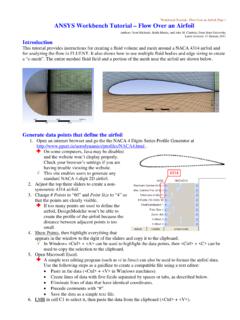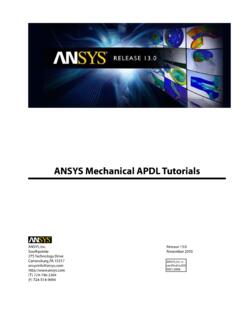Transcription of FLUENT Tutorial Guide - ANSYS.FEM.IR
1 ansys FLUENT Tutorial GuideRelease , 2011 Southpointe275 Technology DriveCanonsburg, PA 15317 ansys , Inc. iscertified to T ) 724-746-3304(F) 724-514-9494 Copyright and Trademark Information 2011 SAS IP, Inc. All rights reserved. Unauthorized use, distribution or duplication is , ansys Workbench, Ansoft, AUTODYN, EKM, Engineering Knowledge Manager, CFX, FLUENT , HFSS and anyand all ansys , Inc. brand, product, service and feature names, logos and slogans are registered trademarks ortrademarks of ansys , Inc. or its subsidiaries in the United States or other countries. ICEM CFD is a trademark usedby ansys , Inc. under license. CFX is a trademark of Sony Corporation in Japan. All other brand, product, serviceand feature names or trademarks are the property of their respective NoticeTHIS ansys SOFTWARE PRODUCT AND PROGRAM DOCUMENTATION INCLUDE TRADE SECRETS AND ARE CONFID-ENTIAL AND PROPRIETARY PRODUCTS OF ansys , INC.
2 , ITS SUBSIDIARIES, OR software productsand documentation are furnished by ansys , Inc., its subsidiaries, or affiliates under a software license agreementthat contains provisions concerning non-disclosure, copying, length and nature of use, compliance with exportinglaws, warranties, disclaimers, limitations of liability, and remedies, and other provisions. The software productsand documentation may be used, disclosed, transferred, or copied only in accordance with the terms and conditionsof that software license , Inc. is certified to ISO 9001 Government RightsFor Government users, except as specifically granted by the ansys , Inc. software license agreement, the use,duplication, or disclosure by the United States Government is subject to restrictions stated in the ansys , license agreement and FAR (for non-DOD licenses).
3 Third-Party SoftwareSee the legal information in the product help files for the complete Legal Notice for ansys proprietary softwareand third-party software. If you are unable to access the Legal Notice, please contact ansys , in the of ContentsUsing This Manual .. xiii1. What s In This Manual .. xiii2. The Contents of the FLUENT Manuals .. xiii3. Where to Find the Files Used in the tutorials .. xiv4. How To Use This Manual .. For the Beginner .. For the Experienced User .. xv5. Typographical Conventions Used In This Manual .. xv1. Introduction to Using ansys FLUENT in ansys Workbench: Fluid Flow and Heat Transfer in a MixingElbow.. Introduction .. Prerequisites .. Problem Description .. Setup and Solution .. Preparation .. Step 1: Creating a FLUENT Fluid Flow Analysis System in ansys Workbench.
4 Step 2: Creating the Geometry in ansys DesignModeler .. Step 3: Meshing the Geometry in the ansys Meshing Application .. Step 4: Setting Up the CFD Simulation in ansys FLUENT .. Step 5: Displaying Results in ansys FLUENT and CFD-Post .. Step 6: Duplicating the FLUENT -Based Fluid Flow Analysis System .. Step 7: Changing the Geometry in ansys DesignModeler .. Step 8: Updating the Mesh in the ansys Meshing Application .. Step 9: Calculating a New Solution in ansys FLUENT .. Step 10: Comparing the Results of Both Systems in CFD-Post .. Step 11: Summary .. 742. Parametric Analysis in ansys Workbench Using ansys FLUENT .. Introduction .. Prerequisites .. Problem Description .. Setup and Solution .. Preparation .. Step 1: Adding Constraints to ansys DesignModeler Parameters in ansys Workbench.
5 Step 2: Setting Up the CFD Simulation in ansys FLUENT .. Step 3: Defining Input and Output Parameters in ansys FLUENT and Running the Simula-tion .. Step 4: Postprocessing in ansys CFD-Post .. Step 5: Creating Additional Design Points in ansys Workbench .. Step 6: Postprocessing the New Design Points in CFD-Post .. Step 7: Summary .. 1303. Introduction to Using ansys FLUENT : Fluid Flow and Heat Transfer in a Mixing Elbow.. Introduction .. Prerequisites .. Problem Description .. Setup and Solution .. Preparation .. Step 1: Launching ansys FLUENT .. Step 2: Mesh .. Step 3: General Settings .. Step 4: Models .. 143iiiRelease - SAS IP, Inc. All rights reserved. - Contains proprietary and confidential informationof ansys , Inc. and its subsidiaries and This ManualThis preface is divided into the following sections:1.
6 What s In This Manual2. The Contents of the FLUENT Manuals3. Where to Find the Files Used in the Tutorials4. How To Use This Manual5. Typographical Conventions Used In This Manual1. What s In This ManualThe ansys FLUENT Tutorial Guide contains a number of tutorials that teach you how to use ANSYSFLUENT to solve different types of problems. In each Tutorial , features related to problem setup andpostprocessing are tutorials are written with the assumption that you have completed one or more of the introductorytutorials found in this manual: Introduction to Using ansys FLUENT in ansys Workbench: Fluid Flow and Heat Transfer in a MixingElbow (p. 1) Parametric Analysis in ansys Workbench Using ansys FLUENT (p. 77) Introduction to Using ansys FLUENT : Fluid Flow and Heat Transfer in a Mixing Elbow (p.)
7 131)and that you are familiar with the ansys FLUENT navigation pane and menu structure. Some steps inthe setup and solution procedure will not be shown to Using ansys FLUENT : Fluid Flow and Heat Transfer in a Mixing Elbow (p. 131)All of the tutorials include some postprocessing instructions, but Postprocessing (p. 1059) is devoted entirelyto The Contents of the FLUENT ManualsThe manuals listed below form the FLUENT product documentation include descriptions ofthe procedures, commands, and theoretical details needed to use FLUENT Getting Started Guide contains general information about getting started with User's Guide contains detailed information about using FLUENT , including informationabout the user interface, reading and writing files, defining boundary conditions, setting upphysical models, calculating a solution.
8 And analyzing your in Workbench User's Guide contains information about getting started with and usingFLUENT within the Workbench Theory Guide contains reference information for how the physical models are imple-mented in UDF Manual contains information about writing and using user-defined functions(UDFs). FLUENT Tutorial Guide contains a number of example problems with detailed instructions,commentary, and postprocessing of Text Command List contains a brief description of each of the commands in FLUENT stext - SAS IP, Inc. All rights reserved. - Contains proprietary and confidential informationof ansys , Inc. and its subsidiaries and Adjoint Solver Module Manual contains information about the background and usageof FLUENT 's Adjoint Solver Module that allows you to obtain detailed sensitivity data for theperformance of a fluid Battery Module Manual contains information about the background and usage ofFLUENT's Battery Module that allows you to analyze the behavior of electric Continuous Fiber Module Manual contains information about the background and usageof FLUENT 's Continuous Fiber Module that allows you to analyze the behavior of fiber flow,fiber properties.
9 And coupling between fibers and the surrounding fluid due to the strong inter-action that exists between the fibers and the surrounding Fuel Cell Modules Manual contains information about the background and the usageof two separat e add-on fuel cell models for FLUENT that allow you to model polymer electrolytemembrane fuel cells (PEMFC), solid oxide fuel cells (SOFC), and electrolysis with Magnetohydrodynamics (MHD) Module Manual contains information about the back-ground and usage of FLUENT 's Magnetohydrodynamics (MHD) Module that allows you to analyzethe behavior of electrically conducting fluid flow under the influence of constant (DC) or oscil-lating (AC) electromagnetic Migration Manual contains information about transitioning from the previous releaseof FLUENT , including details about new features, solution changes, and text command Population Balance Module Manual contains information about the background andusage of FLUENT 's Population Balance Module that allows you to analyze multiphase flows in-volving size distributions where particle population (as well as momentum, mass, and energy)
10 Require a balance FLUENT Under LSF contains information about the using FLUENT with Platform Com-puting s LSF software, a distributed computing resource management FLUENT Under PBS Professional contains information about the using FLUENT withAltair PBS Professional, an open workload management tool for local and distributed FLUENT Under SGE contains information about the using FLUENT with Sun Grid Engine(SGE) software, a distributed computing resource management Where to Find the Files Used in the TutorialsEach of the tutorials uses an existing mesh file. ( tutorials for mesh generation are provided with themesh generat or documentation.) You will find the appropriate mesh file (and any other relevant filesused in the Tutorial ) on the ansys Customer Portal.








